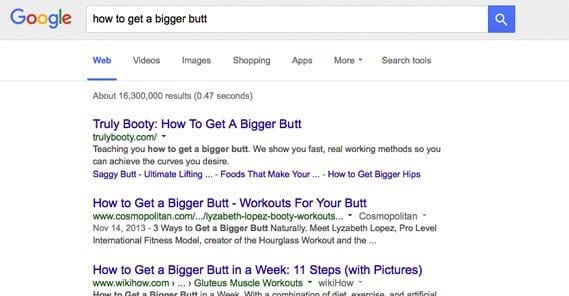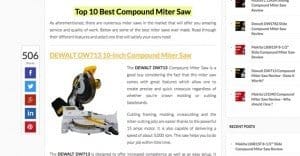How to Build a Niche Site That Makes $1000/mo Income

What would you consider a good level of income from a website? Would you want to make enough to cover your web costs and buy a few beers on the weekend? Do you want enough to be able to take a vacation every six months? How about enough to pay the bills while the rest of your income goes to luxuries and life improvements? Does $1,000 per month sound good?
It’s perfectly doable to reach $1,000 per month from a website, even if you’ve never built a website before and you’re new to the whole online marketing thing. The more experience you have, the easier the process is and the less you’ll have to learn, that’s all. Just remember, despite all of the other tips I’m about to give you, the #1 strategy for success is persistence. The #1 cause of failure in online income generation is giving up too soon.
$1,000 per month is a reasonable goal. It’s only about $34 per day, and you can easily make that from a few sales. Sell a few high-priced affiliate products, or a lot of low priced products. Sell a product of your own that you price at $40 and you’re set with 30 sales per month, one sale per day. You can even afford to skip a few days if you run some ads and make some money based on your traffic as well as your sales. Really, I don’t figure you’ll last long at $1,000 per month; the taste of how easy it can be will have you growing beyond it in no time.
Niche Sites or Authority Sites
There’s a difference between a niche site and an authority site. Authority sites look to become, well, authorities in their industry. They try to be hubs of content, news, and products. An authority site needs work to keep it up to date. It needs content, it needs employees, it needs writers, it needs attention, and a whole lot more.
Niche sites are a little different. They tend to be filled with evergreen content and are updated sparingly, typically only to promote deals or to add new products. They don’t need a lot of upkeep, which is what makes them great for making money online. You have a large up-front investment, and minimal continuing investment, for passive income.
What advantages do niche sites have over authority sites?
- You can set up a lucrative niche site with under 5 blog posts, a home page, some money pages, and your legally-mandated terms and about pages. It doesn’t take much to be indexed in a niche that doesn’t have a lot of competition.
- You don’t need much more than a domain name, cheap web hosting, a WordPress installation, and a few plugins and a theme to go with it. Setting up a Niche site doesn’t require heavy investment with tools or web development.
- Niche sites have a large initial investment in terms of time and effort, but do not cost a lot, nor do they have large ongoing upkeep requirements. Once they’re up and running, they stay that way.
- Niche sites don’t need a lot of personnel support. Typically, you’ll be using affiliate marketing to make your money, so you don’t need to worry about customer support or site upkeep. With tools to minimize spam and the ability to hire freelancers for certain tasks, you’ll be set.
- One niche site can snowball into another. You have all of the technical stuff down once you’ve made one site; you can just copy it and change up the theme, content, and products to make a second site.
- Niche sites can take advantage of gray-hat SEO techniques and, if Google updates, can themselves update and adjust. You don’t need to audit 10,000 pieces of content on a niche site.
That’s not to say that authority sites are without benefit. Here’s what advantage they have:
- Authority sites don’t have to worry about Google algorithm changes quite so much. Where niche sites can be destroyed by one algorithm change, authority sites are more resilient. You have to really be doing something wrong to die off as an authority site.
- Authority sites have a lot more legitimacy behind them. They don’t rely on small pages and gray-hat techniques, so they have a better level of public perception.
- Authority sites have a much higher profit ceiling and room to grow than niche sites. With a niche site, your profits tend to cap out anywhere from $500 a month to $3,000 a month. With an authority site, you can be making $10,000 or more monthly, once you’ve had time to grow.
- Authority sites have more benefits than just money. They build your personal brand, they build name recognition, and they can open up other opportunities along the road. This is good, because it can take a long time for an authority site to reach a significant level of profit.
So, in essence, an authority site can be a very, very lucrative project, but it’s going to cost you a lot in both time and money every month. Some authority sites pay upwards of $3,000 or more every month buying content, buying ads, promoting themselves, and paying site upkeep. They have teams of developers and writers, they have customer service people and product developers, and more. Niche sites don’t have al that.
The reward for being an authority site is the significantly higher income potential. You can sell products, you can sell ebooks, you can run ads, you can drop affiliate links, and all of them work together to bring in a ton of money.
I’m not advocating that you dive into making an authority site, though. Authority sites require a lot more knowledge, investment, and patience than niche sites. I recommend that you build a niche site to get a feel for the process, then build a few more for the passive income. Once you have income and resources from a network of niche sites, you can work on building an authority site on the capital.
Pick a Monetization Strategy
One of the first things you should decide is on a monetization strategy. There are three I’m going to cover here.
- Affiliate links.
- PPC and PPM ads.
- Product sales.
Affiliate links are my recommendation, because they’re incredibly easy to use. You don’t need to worry about placement, you don’t need to worry about ad rotations and fill rates, you don’t need to worry about customer support or shipping or anything else. You make a site, you put some links on it, and you make money. I recommend Amazon, and I’ll discuss why in a moment.
PPC and PPM ads are good, because they’re low-impact and don’t have a lot of investment to set up. On the other hand, they’re also not going to make you much money. A single transaction on Amazon can earn you your daily $30, while PPC and PPM ads might earn you $30 in a whole month. You really need a lot of volume to profit from these ads, but they can’t hurt and can supplement you on some slow days.
You also have to remember that a niche that doesn’t have much competition is probably a niche that doesn’t have many advertisers. That means the advertisers who are willing to target it are doing so because it’s cheap. They won’t be paying you much.
Product sales are more the domain of growing an authority site. It’s hard to sell physical products or digital products you produce with a niche site. The reason people buy is because they have a combination of desire for the product and trust in the seller. Trust is something authority sites build, not niche sites. You won’t have the content, the brand recognition, or the position to build that trust.
That said, you can sometimes sell some products. The two that work best are ebooks and software. A lot of gray-hat and black-hat software is sold in this manner, through multiple niche sites or even through affiliate niche sites. It often makes the software look scammy, though, so be aware of the reputation before you invest in something you want to build a brand around. Ebooks, of course, are easy to sell through Amazon as well as on your site.
The Perks of Amazon Affiliates
Amazon is among the best affiliate programs because it has a lot of power and name recognition. People trust Amazon, where they might not trust another brand. That’s really its primary perk. Amazon’s affiliate program isn’t the most lucrative in terms of individual offers. However:
- Amazon is a hugely trusted brand, so you will have a conversion rate that is much higher than other affiliate programs.
- Amazon has an insanely broad product base, so you can find pretty much anything you want to sell somewhere.
- Amazon gives you a commission on anything purchased by someone who arrived through your link, even if you didn’t link the product itself. You can make hundreds of dollars a month on products you don’t advertise.
- Amazon is also really good at selling accessories and upsells. Just go to any product page and see how many additional, appealing, offers are on that page. Amazon is doing the work for you and you’re reaping the benefits.
Regardless of what monetization strategy you pick, the next step is by far the most crucial.
Pick a Good Niche
There are three things that go into a good niche. Before I tell you what they are, though, I need to say this. Your niche is life. Your niche is the world. Your niche is everything. A bad niche is a failed investment. A good niche is thousands per month. Spend as much time as you need, and more, finding a good niche. Your niche is what makes or breaks your site.
The three elements of a good niche are:
- Product availability. If you’re using Amazon affiliates, for example, you need the products you’re promoting to be available. No “sold out”, no “available on the marketplace” from other sellers. If you’re developing a product of your own, like a piece of software, it works in the opposite direction; there can’t be many products on the market, unless you’re willing to do a lot of work to explain why your product is better than theirs. That’s the realm of authority sites.
- Keyword availability. Niche sites are dominated by, generally, a single keyword. Everything you write, everything you focus on, is a variation of that keyword. You might have two or three primary keywords with a lot of variation, but the point is, that keyword needs to have viability with search. Almost all of your traffic comes from Google searches, so it needs to be a keyword with both low competition and high volume.
- Competitor positioning. The ideal niche is one with a little bit of competition – to have stirred up activity before you arrive – but not a great position. This is so you can dominate the search and out-do the competition with relative ease. Niches with strong competition aren’t good for you.
So, how do you pick a good niche? Niche site research and marketing is one of the most closely and jealously guarded secrets online. No one likes to reveal their secrets or their sites, because that opens them up to competition. The best I can give you is general advice.
First, start brainstorming ideas. Start with products you know a lot about or have experience with. Even if they’re common products, it’s possible that a niche about those products hasn’t been covered. For example, if you know a lot about razors, you can look into shaving, you can look into electric or manual razors, you can look into straight razors, you can look into safety razors, and so forth. Start with broad topics and brainstorm lists of possible ideas. “Safety razors” is a good niche – just look at the Dollar Shave Club as an example of a runaway success – but “razors” alone is not.
A good niche is also a niche with a lot of potential accessories and related products. Shaving, for example, gives you shaving creams and accessories, cleaning products, and other grooming items. The famous survival knife study has all kinds of other survival gear, camping gear, and outdoorsman items as related products. Remember: Amazon does a ton of work to sell the rest of these products to the people you guide to them.
Next, do a lot of keyword research. I mean a lot. No, more than that. I want you to scour every possible combination of words that could possibly be a keyword, relevant or not. Honestly, you’re probably going to want to use a tool to do a lot of the work for you, because the next thing you’re going to do is check the search volumes of every keyword and identify the keywords that can fit with your business model.
Once you’ve found a list of good keyword candidates, look at what already exists for them. Are there niche sites? Are there authority sites? Are there massive sites? If there’s a lot of strong competition, it’s not a good keyword for you to target, and it might not be a good niche.
While you’re looking at competition, look at the prices for the products being marketed. What kind of commissions can you anticipate? Remember, on the performance scale from Amazon, you’re earning about 4% of the product price. This can go up to 8%, but you need volume to reach it, and you won’t have volume when you first start out.
You’ll need to do some calculations. You want $1,000 per month. Your product costs, say, $100. You earn 4% per sale. That’s $4 per sale, which means you need to make 250 sales per month – 9 sales per day – to reach your goal. The math is a little more complex than that, with the performance scale getting you up to $8 per sale, but it’s a general idea of a worst case scenario.
Creating a Site
All of this has been groundwork, you haven’t actually started to make a site yet. Only start to make a site once you’ve identified a niche.
To make a site, you need a few things.
- A domain. Avoid exact match domains these days; Google penalizes them, and you don’t need to start off in a hole.
- A web host. You don’t need a ton of space or a ton of bandwidth, so a cheap package from any decent web host will work.
- A copy of WordPress.org’s package. You don’t need premium, but you do need .org, because the self-hosted .com version is far too limited. This is also why we don’t use Blogger or Wix or any other free site builder.
- A theme. You want to find a classy theme that works on all browsers and devices. You don’t need to pay for a custom theme, but you do need a theme that’s not broadly in use or used by a competitor.
- Plugins. You’ll want something for anti-spam if you have comments or submission forms. Google Analytics is nice to have. Other plugins are per your desires.
- Content. More on this next.
Mechanically, setting up a site isn’t difficult. You’ll have dozens of tutorials and instructional guides to follow to put everything together.
Developing Content
You don’t need a lot of content. In essence, you only need 10 or so pages.
- A homepage. Your homepage should be very robust, because it attracts people to your site. Your theme will play a big part in this.
- An About page. You don’t need a ton of information here.
- A terms of service. These are standard, you can search one up. It should be noindexed, because it’s not necessary to have available in web search.
- Product reviews. These are the meat and potatoes of your site. Product reviews encourage users to buy the product, or at least go to Amazon to check it out, where Amazon does the selling. Each product review should be in the 4,000-5,000 word range, with plenty of detail. This is why it’s good to pick a niche you’re familiar with; it makes writing the reviews easier. This is what a good review looks like.
The more content you have, the more chances you have to rank for various sub-keywords, and the more authoritative you look. However, beware treading down this path; that’s how you become an authority site, and rack up the bills authority sites need to pay.
A Note About Hats: White, Gray and Black
Niche sites are traditionally a gray hat operation. Authority sites are what Google wants, and what Google considers white hat. Niche sites lack a lot of the power of authority sites, and use techniques that aren’t quite against the rules but can get you in trouble when used poorly. Hence, gray hat.
The question of hats is a question of time and investment. A white hat site will take a long time to rank – possibly a year or more – but will have virtually uncapped growth and profits while it exists. A gray hat site will rank faster, in the range of 3-6 months, but will have limited growth potential. A black hat site will rank within a month when done properly, but will only give you a burst of money before it is deindexed and you need to start over.
Whether you stick with the light gray and skirt the line with authority, or go full on black hat, is a personal choice. I don’t recommend black hat sites, I just think it’s too much work to keep recycling, refreshing, and repeating everything every two months to keep money coming in. If you’re putting in that much effort, it’s better to go pure white hat to let the effort keep building.
 ContentPowered.com
ContentPowered.com









